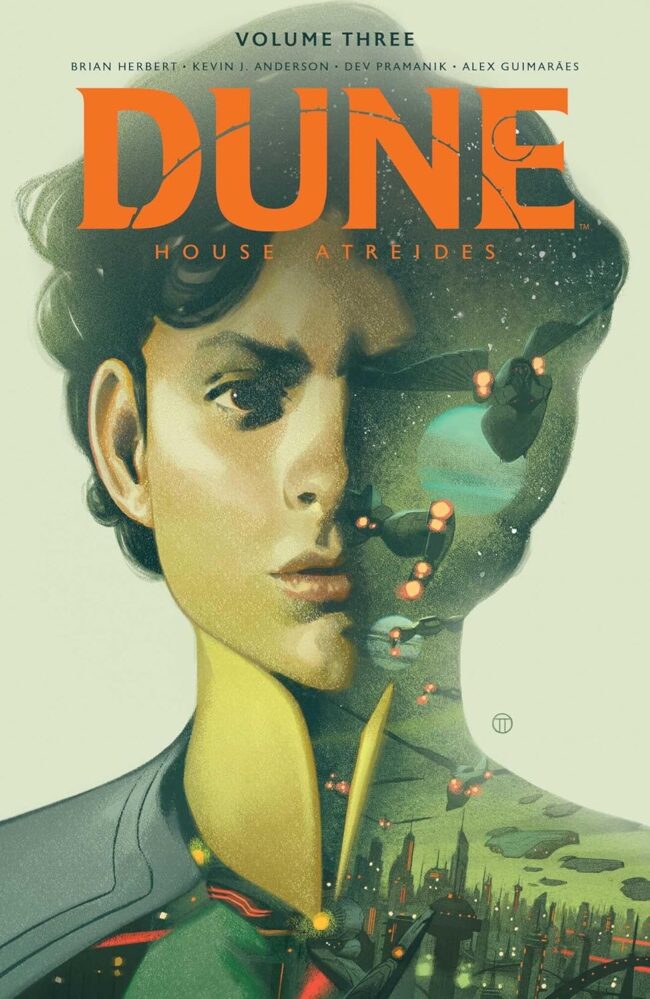
Way back in 1965, author Frank Herbert launched what has become a virtual empire when he published his novel, Dune. That novel led, in following years, to a series of sequels, and in 1984, a movie directed by David Lynch that has since gone on to become both famous and infamous. A reboot of that movie and its own “sequel” followed in 2021 and 2024 respectively. The empire created by Herbert has even extended to the printed page with not one, not two, but three separate prequel series, one focused on House Harkonnen, another one House Atreides, and most recently one on House Corrino. All three of those series have been released by comics publisher, Boom! Studios and in only a matter of days, one of those series – House Atreides – will wrap with the release of Dune: House Atreides Volume 3.
Set for release in comics shops nationwide Apr. 8, Dune House Atreides Volume 3 proves an interesting read in part because of its story, which interestingly leaves the door open for something more in the future. The writing incorporated into the story adds to the engagement ensured in the story, making for more interest. The book’s artwork rounds out its most important elements, completing the presentation. Each item noted here is important in its own way to the whole of Dune: House Atreides Volume 3. All things considered they make this finale to this portion of Boom! Studios’ Dune prequel a fitting end and possible setup to a future expansion of the Dune universe.
Dune: House Atreides Volume 3, the latest addition to Boom! Studios’ expansive Dune universe, is a fitting finale for this portion of the company’s (and author Brain Herbert’s) Dune prequel universe. The book’s appeal comes in part through its story. Spanning approximately 112 pages, the story herein is, as the stories in the first two House Atreides (and those in each of the House Harkonnen and House Corrino books), a multi-faceted presentation but easy enough to follow as long as readers actively, rather than passively read. As the story opens, Leo Atreides has become Duke of House Atreides. This after the death of his father from a bull attack. Leo suspects his own mother and another figure being complicit in his father’s death, ultimately leading to one being banished and the other dying. Readers will be left to find out all of this for themselves. So it does not take long for the new Duke to have to take on a very important decision.
As the story progresses, things get a little more complex as Emperor Elrood IX has died at the hands of his own family as a result of being poisoned. This is gradually set up in the first two volumes of House Atreides. Thanks to Elrood’s untimely death, his son, Shaddam eventually becomes the new emperor. Brain Herbert and Kevin J. Anderson are to be commended for this clear transition from one house to the other (House Corrino). The attention turns to House Harkonnen and the discovery among the group that Elrood IX was working with the Tleilaxu to create a synthetic spice, which would have ruined House Harkonnen’s fortunes, literally and figuratively. A plan is set in motion from there, to ensure that doesn’t happen. The plan in question is to attack a Tleilaxu ship enroute to Shaddam’s coronation and have House Atreides take the blame for the attack, thus crating a war that would also (in House Harkonnen’s view) disrupt the creation of that synthetic spice and save House Harkonnen’s place among the empire. Not to give away too much, but the plan ultimately fails. Leo is forced into another major life moment as a result of the plan, though. The Harkonnens’ plan (which is also part of the House Harkonnen series) dominates the remainder of the story, so all in all the whole is relatively easy to follow, again as long as audiences actively immerse themselves into the overall presentation. It definitely leaves the door open and readers wondering if there is more to come in a bigger Dune universe considering how this volume ends (and that House Harkonnen ends in June). One can only hope that more is to come.
As simple as the story is to follow in this final volume of Dune: House Atreides, it would be nothing without the general writing. Readers will appreciate Herbert and Anderson’s writing from the volume’s opening pages to its last page. Shaddam’s whispering to his friend about the plot to poison his father is one of those classic moments of power struggle stories that has been done in so many franchises out there but is no less engaging here for instance. The writing is also related to the transitions. Again Herbert and Anderson are to be commended here for making the transitions from one of the interweaving stories to the others so clear. Each house’s story begins and ends clearly and the simple introduction through a label pointing out the scene change keeps the overall story moving fluidly, again showing the strength of the writing. The use of blackmail in the bigger story in this volume is another classic power grab plot element used in so many franchises of this one’s ilk. That familiarity and its expert placement within the story adds even more to the writing’s strength. When it is considered alongside the other items examined and that whole along with the rest of the writing, that overall element works in tandem with the story to give readers even more reason to take in this finale for Dune: House Harkonnen.
The artwork exhibited throughout the 100-plus page story rounds out its most important elements. Once again, the team of Dev Pramanik, Alex Guimaraes, and Ed Dukeshire provide the book’s visual presentation. To that end, the look of each cell is familiar for audiences who have been reading the Dune books since each house’s story started. That unique visual presentation proves just as appealing as the book’s story and writing. From the unique coloring and the clear, defined lines of the character designs, to even a moment, such as when Leo attends his trial (the court looks eerily like the United States Supreme Court building), the artwork featured in this book once again offers so much for readers to appreciate. The look that the group has given this and the other Dune books is a near incomparable look to that of other titles from Boom! Studios and even from other publishers. To that end, the aesthetic appeal of Dune: House Atreides Volume Three finishes the book’s overall appeal. When it is considered alongside the book’s story and the writing used to tell the story, the whole makes this final standalone entry in Boom! Studios’ Dune universe a fitting ending to this chapter that also gives hope for more to come.
Dune: House Atreides Volume Three, the last entry in this portion of Boom! Studios’ Dune prequel universe, is a strong ending for this portion of the early Dune years. Its success comes in part through its story, which brings to a head, the story of Duke Leo and Emperor Shabban while leaving the door open for more stories (which is very likely to happen). The writing that was used to tell the story herein builds on the foundation formed by the story, with the books’ artwork putting the final touch to the presentation. Each item examined is important in its own way to the whole of the book. All things considered they make Dune: House Atreides Volume Three a book that most Dune fans will find appealing.
Dune: House Atreides Volume Three is scheduled for release Apr. 8 in comics shops nationwide. More information on this and other titles from Boom! Studios is available at:
Website: https://boom-studios.com
Facebook: https://www.facebook.com/BOOMStudiosComics
Twitter: https://twitter.com/boomstudios








